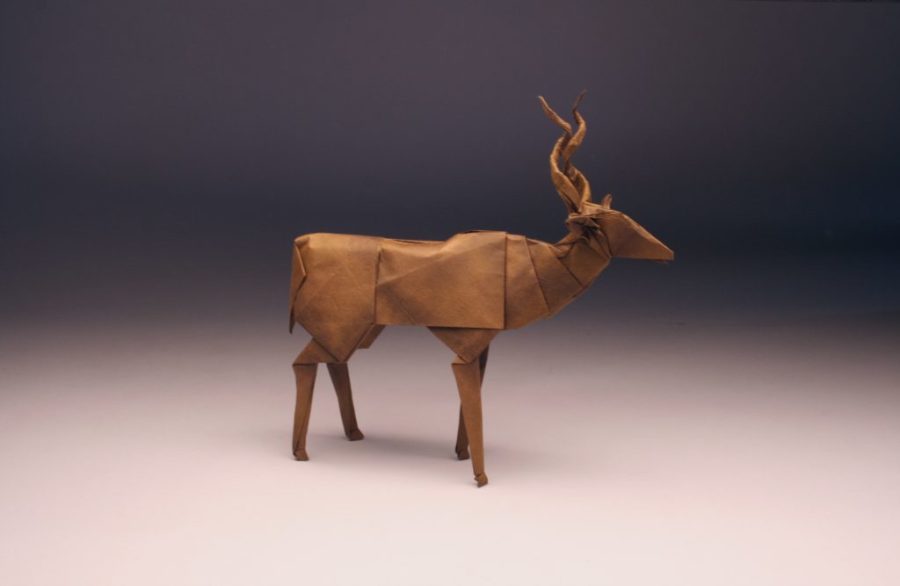A Mathematician’s Origami: Robert J. Lang
Physicist Robert J. Lang, one of the world’s foremost origami artists, has spent over 50 years perfecting his craft, which involves using mathematics and engineering principles in order to create new intricate origami designs and techniques.
Here is one of Robert J. Lang’s original designs and compositions, entitled the ‘Greater Kudu,’ folded from one uncut square of MC-sized Itajime. All of his works are displayed on his website: https://langorigami.com/
Six-year-old Robert J. Lang never dreamed that origami would be more than a passionate hobby in his life. Yet 34 years later, the former NASA engineer found himself quitting his job at the fiber optics company JDS Uniphase to work as a full-time origami artist.
Traditionally, art and science have been categorized as two completely separate teachings. However, one is incomplete without the other as creativity is integral for scientific developments and science serves as a catalyst for human expression. In many ways, art and science work together to unveil what already exists. Since Lang was a teenager, he has worked to bridge the gap between these two seemingly unrelated fields.
Introduced to origami in elementary school by a teacher who exhausted other methods of keeping him engaged in class, Lang established a lifelong partnership with paper – a relationship that kept his head afloat even in tough situations. By following instructions from origami books, he created life with paper. With one continuous movement, his hands give exact directions to the sheet that obediently stays in place: lining up the edges, creasing it, flipping it over, smoothing the borders, and repeating.
Although artistic, Lang’s origami projects also go through a systematic and mathematical design process before being animated on paper. When asked about how he started the process of designing something completely new, he said that it varied.
“For representational work, I typically start by thinking about what the various parts of the subject are and then how they might be represented by folded paper. Then I work on how the different parts will be laid out on the paper, i.e., what part of the paper will become each part of the subject. With that overall notion in mind, then I start working on the specific plan, which is usually a combination of designing (making drawings) and folding (to test out elements of the design).
For geometric/abstract folding, there’s much more variation in the process. Often, those designs start from a desire to explore geometric or mathematical principles of folding, so I am looking for expressions of those principles that also create something beautiful.”
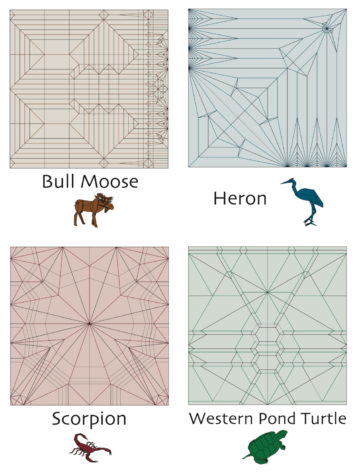
According to his father, Lang was always “a super-duper math whiz,” frequently seen with his nose buried in Martin Gardner’s recreational math column in Scientific American. Lang attended the California Institute of Technology, thinking that he would study math, but soon found himself drawn more towards electrical engineering as he preferred “building things.” During stressful times, he used origami as an escape from the pressures of undergraduate studies. He would create new designs, record them, and then throw them away. After graduating from Caltech, he moved on to earn his master’s degree in electrical engineering at Stanford University.
Lang made the connection between math and origami quite early on in his design career. “I recognized that there were fixed principles — regularities of Nature — that I could (and had to) rely on in my designing,” he explained. “Things like the minimum separation between flaps on the paper being related to the desired lengths of the flaps.” He started attempting to describe these regularities using mathematical concepts in graduate school, which ended up being the final connection to the beginning of his mathematics-based art.
In a Stanford Magazine interview from 2011, Lang elaborated, “It was clear there were underlying natural laws that limit what you can and can’t do. And if I could identify what those laws were explicitly, then I could use mathematical tools to make the things I really wanted to make.”
Alongside his studies at Stanford, Lang started planning for his first book, The Complete Book of Origami, which was published in 1988. After Stanford, he returned to Caltech for a doctorate in applied physics and, after graduation, moved to Germany with his wife, Diane Davis. Here he spent three months designing one of his most famous works — a life-size paper cuckoo clock featuring a deer head with antlers, a bird perched on an extended platform, a face with hour and minute hands, pinecone-shaped weights, and a pendulum. This was the most complicated piece of origami folded from a single sheet of paper during the time and it propelled Lang’s reputation into exclusive origami circles.
For the next 14 years, while working as a laser physicist at NASA’s Jet Propulsion Laboratory and later under Spectra Diode Labs/JDS Uniphase, Lang worked on planning his next book focused around how to design any model one wanted. In 2001, he quit his day job to focus completely on the completion of his book, Origami Design Secrets: Mathematical Methods for an Ancient Art, which was published in 2003.
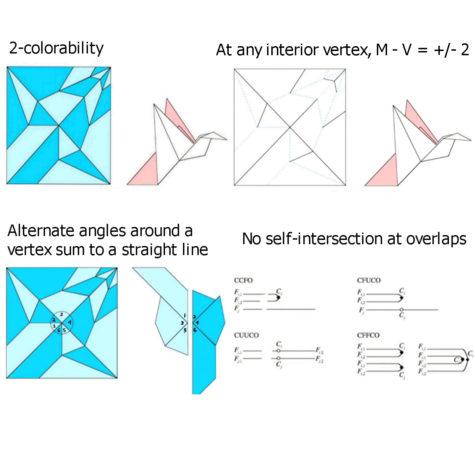
In a 2008 Ted Talk video, Lang simplified the general process discussed in Origami Design Secrets. In an attempt to demonstrate how anyone can make origami, he explained the four basic laws that one can employ to translate a vision onto paper.
“The first law is two-colorability. You can color any crease pattern with just two colors without ever having the same color meeting. The directions of the folds at any vertex – the number of mountain folds, the number of valley folds – always differ by two. If you look at the angles around the fold, you find that if you number the angles in a circle, all the even-numbered lines add up to a straight line, and all the odd-numbered angles add up to a straight line. And if you look at how the layers stack, you’ll find that no matter how you stack folds and sheets, a sheet can never penetrate a fold. That’s all you need in origami.”
Lang then diagramed how to plan out the shapes of a desired subject using his original design of a stag beetle. “I start out with an idea. I abstract it. What’s the most abstract form? It’s a stick figure. And from that stick figure, I somehow have to get to a folded shape. That has a part for every bit of the subject, a flap for every leg. And then once I have that folded shape that we call the base, you can make the legs narrower, you can bend them, you can turn it into the finished shape.”
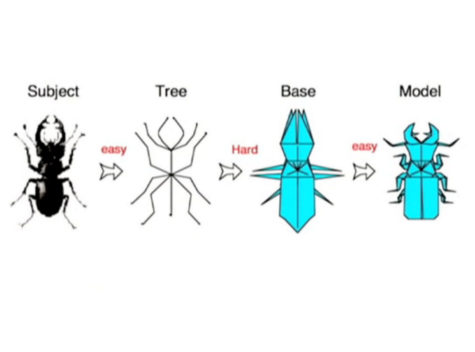
Most of Lang’s models depict nature and animals. “I’ve always loved animals and Nature, and origami was a way of re-creating the feelings I have had for the real thing,” said Lang. In the Stanford Magazine interview, he further explained how he takes inspiration from the simple things in life.
“The folds that I spend the most time and effort on are the ones that most move me when I see the real thing. A bird’s wings, a head, a tail, and, if you want to be fancy, feet, and that’s it. But the emotional response I get when I see a real soaring red-tailed hawk, that’s what I want to capture in the fold. And I keep working and I think each time I do a new raptor, I get a little better at capturing that emotion.”
Not only does Lang take origami inspiration from the real world, but he also uses origami as a method of problem-solving to contribute to real-world solutions. Lang has worked with the Lawrence Livermore National Laboratory (LLNL) in order to figure out how to send a 100-meter diameter glass telescope lens to space in a small rocket. How do you make a large sheet of glass smaller? You have to fold it.
Lang worked with other engineers to design a pattern that allows flat rings or discs to fold down into a compact cylinder. The prototype was 5-meter which folded to about 1.5-meter. Although the telescope never made it to space, Lang’s collaboration with the LLNL led him to other jobs, including making a NASA solar shroud, a heart support implant, an airbag computer simulation, and a compact cell phone antenna.
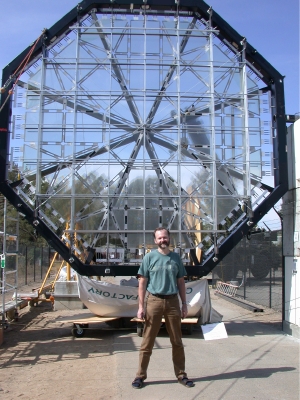
Lang is also constantly learning about mathematics and algorithms through his origami. “Algorithms, and the computer programs that are based on them, are tools; often very specialized tools. They work very well for the problems that they are designed for, but one must always be careful not to try to use them for the wrong problem — rather like trying to use a hammer when a screwdriver is needed. So, when an algorithm ‘doesn’t work, or not as well as expected,’ it’s usually because my expectations were wrong: I was trying to use them for the wrong problem. Sometimes, though, when an algorithm doesn’t work, it’s a sign of a deeper mathematical issue — an assumption baked into the algorithm that isn’t actually correct. So in that sense, an “error” in using an algorithm can actually be a clue that there’s some further mathematics to be explored.”
Like most art forms, complete mastery is inconceivable so even the slightest advances are always revolutionary. Lang has helped to pioneer a new generation of origami art and to further bridge the gap between art and science. And most importantly, he continues to experiment and expand his artistic and mathematical knowledge. “Lately, I haven’t done a lot of design work, but I am tinkering with a few subjects; some further bird designs, and, on the mathematical front, exploring some mathematics-related to curved folding.”
To see all of Robert J. Lang’s origami creations, please visit his website at https://langorigami.com/
“The folds that I spend the most time and effort on are the ones that most move me when I see the real thing,” explained Robert J. Lang. “A bird’s wings, a head, a tail, and, if you want to be fancy, feet, and that’s it. But the emotional response I get when I see a real soaring red-tailed hawk, that’s what I want to capture in the fold. And I keep working and I think each time I do a new raptor I get a little better at capturing that emotion.”
Paromita Talukder is a Copy Chief for ‘The Science Survey’ where she explores topics ranging from online activism to clubs at Bronx Science. She sees...

